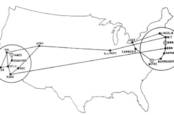This article is more than 1 year old
RIP Katherine Johnson: The extraordinary NASA mathematician astronauts trusted over computers
'She was an American hero and her pioneering legacy will never be forgotten'
OBIT Katherine Johnson, the pioneering African-American mathematician whose calculations ensured NASA's astronauts safely set foot on the Moon in 1969, died today. She was 101.
Born Katherine Coleman on August 26, 1918, she was an exceptionally precocious child, and was allowed to skip several grades ahead in school. Mentored by William Schieffelin Claytor, the third African American to achieve a PhD in mathematics, Johnson graduated summa cum laude from West Virginia State College, with degrees in mathematics and French, at the age of 18.
Despite her top grades, though, she was unable to find a job in academia during a time when African Americans were heavily discriminated against. Instead, she became a school teacher. She then married her first husband James Goble in 1939, quit teaching, and attended graduate school at West Virginia University after she was chosen, alongside two men, to be the first black students there. But she dropped out a year later when she became pregnant, and focused on her new family.
She turned to teaching after giving birth to three daughters, Constance, Joylette, and Katherine, in all. Her career at NASA – known then as the National Advisory Committee for Aeronautics (NACA) – didn’t begin until 1953, after a relative told her the Langley Research Center in Virginia was hiring for the blacks-only wing of its computing section.
She joined as a temp, and was told to analyze data compiled from flight tests. Her role was made permanent two weeks later, after bosses recognized her mathematical abilities.
Her husband James died of a brain tumor in 1956, leaving her a single mother of three children at 38. In 1959, she married US Army officer James Johnson, and their family grew to include six grandchildren and 11 great-grandchildren. Jim died last year, aged 93.
Get the girl!
She continued to dedicate herself to her job, working long hours during the turbulent time of the Cold War and the Space Race. America threw significant resources at the task of sending humans into space to outdo the Soviet Union, which had just launched Sputnik, the first artificial satellite in 1957.
Johnson calculated the trajectory for America’s first human spaceflight that saw NASA 'naut Alan Shepard briefly leave Earth’s atmosphere in a Freedom 7 Mercury capsule in 1961. A year later, she was called to double check the workings of computers to make sure spaceman John Glenn would safely make it back to Earth after taking off in an Atlas LV-3B rocket.
Glenn didn’t quite trust the machines to run the numbers: they were prone to errors and blackouts. He reportedly asked engineers to “get the girl,” meaning Johnson, to repeat the same trajectory calculations using nothing but a pen, a ruler, some paper, and a mechanical calculator. “If she says they’re good, then I’m ready to go,” he said. Glenn became the first American to orbit the Earth in 1962.
“I loved going to work every single day,” Johnson later said. She reckoned her best contribution to NASA was for the historic Apollo 11 landing. Her trajectory calculations, and backup navigational charts, ensured the project’s lunar lander, carrying Neil Armstrong and Buzz Aldrin, set down safely on the surface of the Moon.
During her time at NASA, Johnson published numerous research papers detailing new equations for figuring out the landing position of spacecraft. This marked the first time the space agency's Flight Research Division had publicly given a woman credit as an academic author.
After 33 years of service, she retired in 1986. And despite her long and illustrious career, she remained relatively unknown outside of the field. In 2015, President Barack Obama presented her, at the age of 97, with the Presidential Medal of Freedom, America's highest civilian award.
A year later, her life was depicted in Hidden Figures, the Hollywood film based on a nonfiction book, written by Margot Lee Shetterly, describing the careers of black female mathematicians in NASA during the Space Race.
“Our NASA family is sad to learn the news that Katherine Johnson passed away this morning at 101 years old,” Jim Bridenstine, NASA’s Administrator said on Monday. “She was an American hero and her pioneering legacy will never be forgotten." ®

